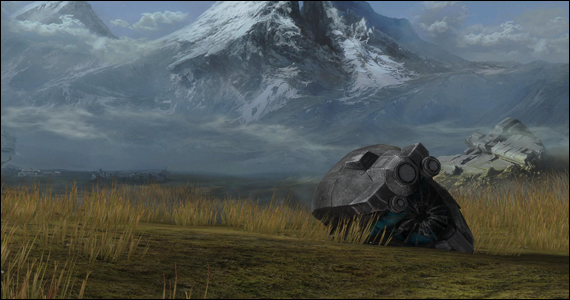
It’s 2010 now, and at this stage in the videogame universe reviewing a Halo game seems largely unnecessary. You’ve played it. You know what it is. You know if you’re prepared to spend your sixty-dollars for it. Still, there are some things about Reach that deserve to be said, so we’re going to say them, regardless of the fact that you already bought the game on launch day.
When I reviewed StarCraft II I wrote that a level of perfection in the gameplay design allowed the original StarCraft to endure, without sequels, far longer than any game has a right to. The Halo franchise is characterized by a similar condition with opposite results; in this case, a string of fundamentally similar sequels have been produced, capitalizing on the natural strength of the core gameplay mechanic.
When I tell you, then, that Reach is the best game in the series, you may ultimately find the endorsement less meaningful than it seems, as the gradient of quality within this series is fairly narrow. That is to say, Halo is like Halo 2 is like Halo 3, and while there are criteria by which we can say one is better than the other, the differences are pretty slim. So, if you never liked Halo (all two of you), the fact that Reach is the best of the series offers you nothing, as it’s just as much Halo as ever. Still, there is something to be said for being the strongest game in what is arguably the industry’s strongest franchise; the best of the best, as it were.
One wonders how much freedom Bungie felt they had in the production of these games, and also, how much freedom Microsoft allowed them. It hardly seems accidental that the bulk of expansion in these releases has been in fortifying the online experience—a realm in which Bungie is completely unmatched on the console market. Yes, with players (and Microsoft) dedicated to the classic Halo gameplay offering, the online arena is one of the few areas Bungie would feel free to move unimpeded. Accordingly, the multiplayer experience has become increasingly complex and refined with each offering, and Reach follows this trend.
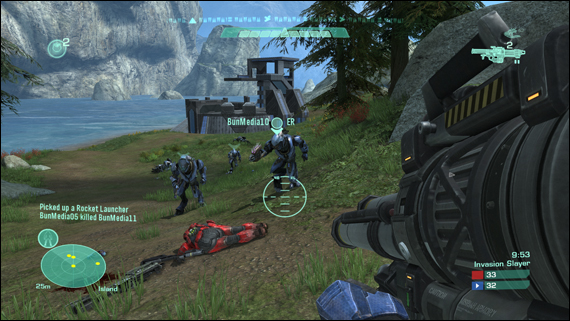
Veterans of ODST will immediately notice that Firefight can now be played via matchmaking, which is to say you may actually have a reason to play Firefight. With this gross oversight from ODST corrected, Firefight is now available in a bite-sized portion prepared carefully for Halo online players—it’s quick, it’s brutal, and it’s easy to find a group. A small selection of modified gameplay modes (such as “Gruntpocalypse”) provide a fun outlet for players looking to fool around in a light environment, while the single-player Score Attack mode delivers relief for the hardcore wishing to assert dominance over their friends list with preposterously high scores.
New to Reach are Challenges, another facet of Bungie’s online strategy. Available in both the daily and weekly varieties, challenges provide players with the opportunity to earn credits by completing particular tasks—such as eliminating a certain number of enemies with a particular weapon or in a particular game mode. This serves to encourage players who might not otherwise spend time in a mode such as Firefight to explore the game’s ample offerings. In the past, it’s been easy to simply return to one playlist, over and over, merely out of habit and comfort. With challenges, players will find themselves required to leverage all of the game modes to maximize their reward.
Also in this vein come Commendations, which track player feats (such as kills with precision weapons or vehicles) and offer credit rewards. As with challenges, commendations encourage players to explore the assets of the game. If you want the ludicrously expensive voice of the Master Chief in Firefight, you’re going to find yourself combing through the commendations for each game mode and grinding them out.
Expansion is the name of the game, and it’s evident in all corners of the online experience. Refined playlists, superior customization for private games, a superior Forge, and more game types all lend to a consistently fantastic experience. Spartan customization from Halo 3 has seen a total overhaul, with a slew of options and a progression system that ties into every single game mode, multiplayer or otherwise. One could probably write several distinct reviews on the Reach online suite, but since you probably don’t have time to read Reach: A Review In Sixty-Seven Parts, suffice to say that Bungie continues to improve the standout multiplayer experience in the industry.
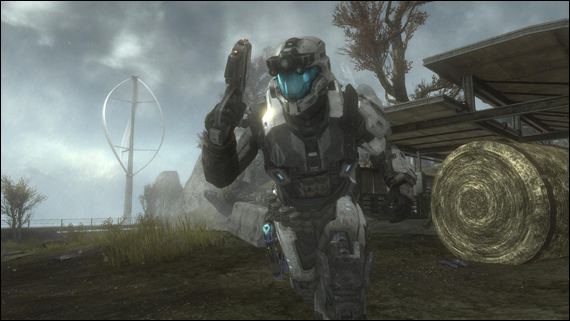
On the campaign side, Reach delivers the same strong co-op offering as always, with a meticulously tuned and designed campaign. There’s a significant selection of new weapons, including the DMR and Needle Rifle, which are destined to become fan-favourites. A small offering of new enemies and vehicles spice things up—a new breed of Jackal will dash across maps and literally bound up cliffsides, repositioning to destroy you with greater efficiency, while the Covenant Revenant serves as a mini-tank with increased mobility, and the UNSC Falcon offers a few fun rail-shooter sequences to break up the action. Armour abilities lend new strategic avenues to players wishing to cater to their own playstyles, and contribute the most towards making Reach feel fresh. These additions come packaged in a significantly refined system with a number of tweaks to health, shields, and even weapon accuracy.
In spite of all the refinements, Reach is perhaps the first game in the series to introduce obvious balance problems. You’ll encounter enemies wielding extremely powerful weapons that will annihilate you instantly—and when you finally overcome these enemies, you’ll pick up those terrifying new technologies to discover that they really aren’t that useful. The new Focus Rifle is a prime example: on Heroic or Legendary, you will never kill an Elite with the focus rifle. Ever. Enemies may kill you with the weapon, and indeed, your shields will fail instantly should the beam cross your path—but should the player attempt to use the device on any shielded enemy, the battery will simply drain uselessly as the enemy ducks behind cover to regenerate. The Concussion Rifle is equally useless in the face of the perpetually dodging Elites, while those same enemies will use the weapon to decimate the player. Carrying the beam sword is an invitation to be slaughtered by the Elite melee attack, and Elites often shrug off blasts from the fuel rod gun.
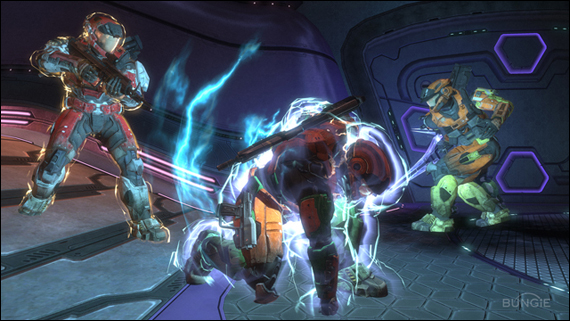
It can be frustrating to encounter opposition that can often seem invincible. Unfortunately, playing on higher difficulties largely removes many gameplay opportunities, as attempting to jack a vehicle or use a new weapon will often result in instant death. Players will find it is simply far safer to carry a DMR, rather than risk more extravagant gameplay strategies. Reach, with its staggering difficulty, demands to be played with a utilitarian approach.
Enemies are more dangerous than ever, especially Elites—who will murder you repeatedly as you drain clips uselessly into their regenerating shields, requiring that you drop them instantly with a headshot once you’ve defeated their shields, lest they simply return and destroy you. Invariably, Elites are better equipped, more powerful, and more accurate than the human player. What’s more, they dodge endlessly, mitigating the usefulness of your sniper rifles and heavy weapons.
This lends to an increased emphasis on bringing the right tools to the battle. The needle rifle is unstoppable against the unshielded Brutes, while combining the plasma pistol with a headshot-capable weapon is the only way to fight Elites. Automatic weapons, however, are left out in the cold, as on Heroic and Legendary there is hardly an occasion to ever carry one. When even grunts and jackals pose a significant threat, it is far safer to carry a headshot weapon to drop them quickly.
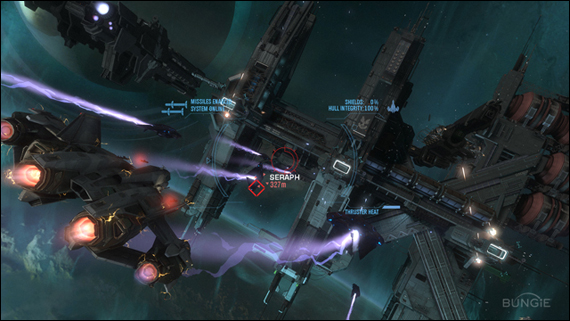
It quickly becomes apparent that the desire to create the sense of a losing battle informs all aspects of the Reach campaign. The massive set-pieces of Halo 3 are employed far more sparingly here, and it’s not difficult to understand why: smashing through Covenant armies created the distinct impression that the player was some invincible electric war god, something distinctly inappropriate for the Reach experience. Equally, with enemies more deadly than ever, piling them on in such a manner could serve to render the game unbeatable.
Instead, Noble-Six can normally be found on the quieter side of the battle, employing small-force infiltration to accomplish his goals while the war effort sours in the distance. The pacing also follows this trend; as the campaign approaches its end, the sense is of a battle winding down, toward loss, rather than an adventure reaching its climax. In a game with story employed so sparingly, this sensation is notable. Yes, as with previous entries, Bungie remains light on storytelling, giving you the bare minimum to create the appropriate atmosphere and provide the player with the necessary information to move forward. The reality of the Halo games has always been that in order to truly experience the narrative of the universe, one must look to the ancillary material, like the novels. While this serves the pacing of the game, there are a couple of noteworthy failings here.
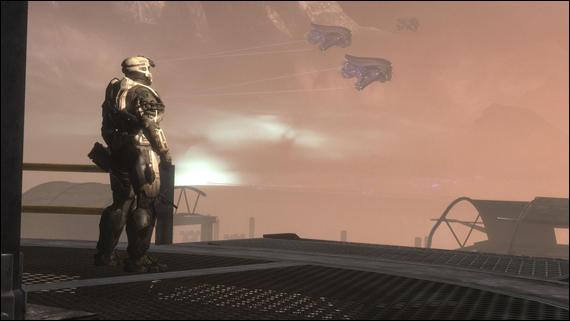
The most obvious is how little of Reach the player sees. The Covenant are suddenly everywhere, and by the time you get anywhere, they’ve already laid waste to it. There’s no image of Reach before the storm, so to speak, which somewhat diminishes the effect of seeing cities ravaged and burned by Covenant forces. Very little is seen of the Covenant’s side of this war, so it’s difficult to conceive of their strategy or how they were able to establish their foothold so quickly. Part of the strength of Halo 2 and Halo 3 was that players were exposed to the culture and inner workings of the Covenant. Here, Elite’s are anonymous, howling monsters that merely exist as your opposition. While one can understand the desire to make the Covenant frightening once more, it’s easy to feel as if something has been lost.
Still, Reach manages to provide a stronger personal connection to the events and characters than previous entries, guaranteeing that players will feel the fall of Reach as they play. The closing moments are some of the strongest in the series, with a final mini-mission after the credits just as memorable as Halo 3’s world-shaking finale. There is a sense of finality here, knowing that the series has come full circle, but the sliver of hope the ending offers will immediately have players dusting off copies of Combat Evolved, ready to experience the series all over again.
Reach itself delivers the strongest product in the franchise to date, and though it’s easy to feel as if you’ve played this all before, careful additions and refinement of the core gameplay will quickly suck players in—while the sheer number of ways to play will keep them coming back.
Halo: Reach
Developer – Bungie
Publisher – Microsoft Game Studios
System – Xbox 360
Release Date – September 14, 2010
*A copy of this title was provided by the publisher for review